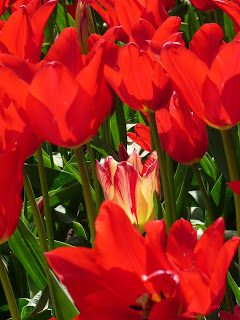
In just a few days, the world has become afraid to breathe.
All of a sudden, anyone coughing or feverish or imagining a scratchy throat is sure he's got Swine Flu. And all he had to do was inhale.
BTW, this malady will not be renamed, despite an MSNBC story reporting Jews offended at the term because pigs aren't kosher. (And flu is?)
In our northwesterly corner of the country, the Seattle Times blares in a headline much larger than the masthead, "Swine flu found here." I can see students perking up; they're talking about closing all the schools because three unconfirmed cases have surfaced. One of them, an 11-year-old boy who attends Madrona K-8, gave his fellow pupils there an unexpected vacation--the institution closed down for a week (the boy's doing just fine).
Meanwhile, 230,000 five-day courses of Tamiflu antidote are on their way to our area. When health officials announce such things, people think, "uh-oh, we're going to need it!" And so hospitals and clinics are filling up--with people who want to be tested, just in case. We're not going to get the "reagents" required to confirm that Swine Flu is here until next week, but the runaway publicity is enough to make you sick.
Even if you're not. Ubiquitous photos of people in blue face masks everywhere foster paranoia, but this is just the latest manifestation of the overkill of medical information. Remember SARS? That got the same publicity treatment a couple years ago. Not nice to endure, I'm sure, but certainly not the pandemic it was predicted to be. Avian flu got a lot of ink (nowadays, a lot of pixels) and is more deadly than its Swinely counterpart, but despite the scare, it fizzled out near where it began.
Cancer. It's everywhere and nobody knows when and who it will strike. But thousands of books, websites and blogs document its grisly course and the agonies of its treatment, mounting in our consciousness. Hospitals court clients with ads reminding, "It's your cancer..." Heart-rending stories of valiant children battling disease are the staples of grocery-store check-out line mags. Fundraisers for every illness increase awareness of maladies we can't spell, but now personally fear. Radio ads seek participants in clinical trials for diabetes, dementia, insomnia. As I write this, I hear a radio ad that assumes all men are desperate for "prostate support:" "So why wouldn't you try new Beta Prostate?"
In so (too) many words: you're a goner. You're in line for enlarged prostate, some kind of cancer, and now, Swine Flu, no matter what you do. Wash your hands. Take bee pollen. Avoid eating red meat. Wear a surgical mask. Better, don't read the newspaper (I know, nobody does anyway), or listen to the radio, or check online news. BTW, in every normal year, 35,000 Americans die from flu. Mexico, its 75,6066 square miles being ground zero for the porcine problem, has had 99 cases, total.
Okay, the World Health Organization yesterday gave Swine Flu a level five pandemic warning--meaning it's imminent, crouching at your door, seeping through the cracks. But I just don't know how much more paranoid we can get. We're already hyper-aware of disease risks; kindergartens require parents to provide bottles of anti-bacterial gel along with pencils and crayons for their kids.
Panic among the population may soon mean isolation--Mexico's President Philipe Calderon told all citizens to stay home, inside, and all non-essential services are suspended for five days. (Starbucks closed ten of its Mexico City stores, so you know this is serious, but it's got 249 others in the country.)
Why don't I hyperventillate over Swine Flu? Because unlike cancer, it can be prevented, has a relatively simple treatment, can be tackled with drugs, and is unlikely to be deadly any more than "normal" flu. But you can bet in the next month or so, we'll have a swine-specific vaccine for sale in every drugstore.
Each autumn we receive relentless urgings to get flu shots. I used to listen to them, but every year I got a flu shot, I lost two weeks to some bug, shivering, sweating and miserable (probably one not covered by the vaccine). Every year I did not get a flu shot, I stayed healthy.
Should we bolt when somebody sneezes? Twitch rather than scratch our noses? Refuse to shake hands? Should we avoid movie theaters, and wear rubber gloves for escalator handrails? Should we live our lives even more worried about infection than we already are?
Well, it's up to you. But the next time I see you when I dash into the supermarket, maybe we oughta just wave hi.
(Reuters photo above is couple saying goodbye at Cancun airport)
















